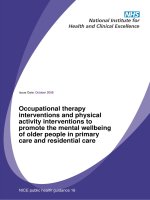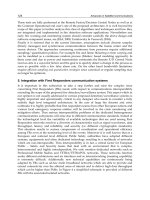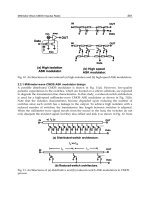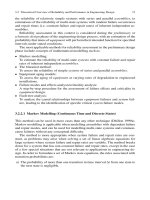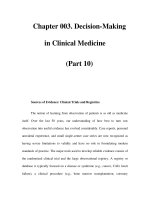Current practice guidelines in primary care - part 10 pptx
Bạn đang xem bản rút gọn của tài liệu. Xem và tải ngay bản đầy đủ của tài liệu tại đây (656.48 KB, 21 trang )
APPENDIX VI: ESTIMATE OF 10-YEAR STROKE RISK 195
ESTIMATE OF 10-YEAR STROKE RISK FOR MEN
Age (y) Points
Untreated Systolic Blood
Pressure (mm Hg) Points
54–56 0 97–105 0
57–59 1 106–115 1
60–62 2 116–125 2
63–65 3 126–135 3
66–68 4 136–145 4
69–72 5 146–155 5
73–75 6 156–165 6
76–78 7 166–175 7
79–81 8 176–185 8
82–84 9 186–195 9
85 10
196–205
10
Treated Systolic Blood
Pressure (mm Hg) Points History of Diabetes Points
97–105 0 No 0
106–112 1 Yes 2
113–117 2
118–123 3
124–129 4
130–135 5
136–142 6
143–150 7
151–161 8
162–176 9
177–205 10
Cigarette Smoking Points Cardiovascular Disease Points
No 0 No 0
Yes 3 Yes 4
Atrial Fibrillation Points
Left Ventricular
Hypertrophy on
Electrocardiogram Points
No 0 No 0
Yes 4 Yes 5
Point Total 10-Year Risk % Point Total 10-Year Risk %
1 3 16 22
2 3 17 26
3 4 18 29
4 4 19 33
5 5 20 37
6 5 21 42
7 6 22 47
8 7 23 52
9 8 24 57
10 10 25 63
11 11 26 68
12 13 27 74
13 15 28 79
14 17 29 84 10-Year Risk _____%
15 20 30 88
Source: Modified Framingham Stroke Risk Profile. Circulation 2006;113:e873–923.
196 APPENDIX VI: ESTIMATE OF 10-YEAR STROKE RISK
ESTIMATE OF 10-YEAR STROKE RISK FOR WOMEN
Age (y) Points
Untreated Systolic Blood
Pressure (mm Hg) Points
54–56 0 95–106 1
57–59 1 107–118 2
60–62 2 119–130 3
63–64 3 131–143 4
65–67 4 144–155 5
68–70 5 156–167 6
71–73 6 168–180 7
74–76 7 181–192 8
77–78 8 193–204 9
79–81 9 205–216 10
82–84 10
Treated Systolic Blood
Pressure (mm Hg) Points History of Diabetes Points
95–106 1 No 0
107–113 2 Yes 3
114–119 3
120–125 4
126–131 5
132–139 6
140–148 7
149–160 8
161–204 9
205–216 10
Cigarette Smoking Points Cardiovascular Disease Points
No 0 No 0
Yes 3 Yes 2
Atrial Fibrillation Points
Left Ventricular
Hypertrophy on
Electrocardiogram Points
No 0 No 0
Yes 6 Yes 4
Point Total 10-Year Risk % Point Total 10-Year Risk %
1 1 16 19
2 1 17 23
3 2 18 27
4 2 19 32
5 2 20 37
6 3 21 43
7 4 22 50
8 4 23 57
9 5 24 64
10 6 25 71
11 8 26 78
12 9 27 84
13 11 28
14 13 29 10-Year Risk _____%
15 16 30
Source: Modified Framingham Stroke Risk Profile. Circulation 2006;113:e873–923.
APPENDIX VII: IMMUNIZATION SCHEDULES 197
198 APPENDIX VII: IMMUNIZATION SCHEDULES
FOOTNOTES
1. Hepatitis B vaccine (HepB). (Minimum age: birth)
At birth:
• Administer monovalent HepB to all newborns before hospital discharge.
• If mother is hepatitis surface antigen (HBsAg)-positive, administer HepB and 0.5 mL
of hepatitis B immune globulin (HBIG) within 12 hours of birth.
• If mother’s HBsAg status is unknown, administer HepB within 12 hours of birth.
Determine the HBsAg status as soon as possible and if HBsAg-positive, administer
HBIG (no later than age 1 week).
• If mother is HBsAg-negative, the birth dose can only be delayed with physician’s order and
mother’s negative HBsAg laboratory report documented in the infant’s medical record.
After the birth dose:
• The HepB series should be completed with either monovalent HepB or a combination
vaccine containing HepB. The second dose should be administered at age 1–2 months. The
final dose should be administered at age ≥ 24 weeks. Infants born to HBsAg-positive
mothers should be tested for HBsAg and antibody to HBsAg after completion of ≥ 3 doses
of a licensed HepB series, at age 9–18 months (generally at the next well-child visit).
4-month dose:
• It is permissible to administer 4 doses of HepB when combination vaccines are
administered after the birth dose. If monovalent HepB is used for doses after the birth
dose, a dose at age 4 months is not needed.
2. Rotavirus vaccine (Rota). (Minimum age: 6 weeks)
• Administer the first dose at age 6–12 weeks. Do not start the series later than age 12 weeks.
• Administer the final dose in the series by age 32 weeks. Do not administer a dose later
than age 32 weeks.
• Data on safety and efficacy outside of these age ranges are insufficient.
3. Diphtheria and tetanus toxoids and acellular pertussis vaccine
(DTaP). (Minimum age: 6 weeks)
• The fourth dose of DTaP may be administered as early as age 12 months, provided 6
months have elapsed since the third dose.
• Administer the final dose in the series at age 4–6 years.
4. Haemophilus influenzae type b conjugate vaccine (Hib). (Minimum age: 6 weeks)
• If PRP-OMP (PedvaxHIB® or ComVax® [Merck]) is administered at ages 2 and 4
months, a dose at age 6 months is not required.
• TriHiBit® (DTaP/Hib) combination products should not be used for primary immunization
but can be used as boosters following any Hib vaccine in children aged ≥ 12 months.
5. Pneumococcal vaccine. (Minimum age: 6 weeks for pneumococcal conjugate vaccine
[PCV]; 2 years for pneumococcal polysaccharide vaccine [PPV])
• Administer PCV at ages 24–59 months in certain high-risk groups. Administer PPV to
children aged ≥ 2 years in certain high-risk groups. See MMWR 2000;49(No. RR-9):1–35.
6. Influenza vaccine. (Minimum age: 6 months for trivalent inactivated influenza vaccine
[TIV]; 5 years for live, attenuated influenza vaccine [LAIV])
• All children aged 6–59 months and close contacts of all children aged 0–59 months are
recommended to receive influenza vaccine.
• Influenza vaccine is recommended annually for children aged ≥ 59 months with certain
risk factors, health-care workers, and other persons (including household members) in
close contact with persons in groups at high risk. See MMWR 2006;55(No. RR-10):1–41.
• For healthy persons aged 5–49 years, LAIV may be used as an alternative to TIV.
• Children receiving TIV should receive 0.25 mL if aged 6–35 months or
0.5 mL if aged
≥ 3 years.
• Children aged < 9 years who are receiving influenza vaccine for the first time should
receive 2 doses (separated by ≥ 4 weeks for TIV and ≥ 6 weeks for LAIV).
7. Measles, mumps, and rubella vaccine (MMR). (
Minimum age: 12 months)
• Administer the second dose of MMR at age 4–6 years. MMR may be administered before
age 4–6 years, provided ≥ 4 weeks have elapsed since the first dose and both doses are
administered at age ≥ 12 months.
8. Varicella vaccine. (Minimum age: 12 months)
• Administer the second dose of varicella vaccine at age 4–6 years. Varicella vaccine may
be administered before age 4–6 years, provided that ≥ 3 months have elapsed since the first
dose and both doses are administered at age ≥12 months. If second dose was administered
≥ 28 days following the first dose, the second dose does not need to be repeated.
9. Hepatitis A vaccine (HepA). (Minimum age: 12 months)
• HepA is recommended for all children aged 1 year (ie, aged 12–23 months). The 2 doses
in the series should be administered at least 6 months apart.
• Children not fully vaccinated by age 2 years can be vaccinated at subsequent visits.
• HepA is recommended for certain other groups of children, including in areas where
vaccination programs target older children. See MMWR 2006;55(No. RR-7):1–23.
10. Meningococcal polysaccharide vaccine (MPSV4). (Minimum age: 2 years)
• Administer MPSV4 to children aged 2–10 years with terminal complement deficiencies
or anatomic or functional asplenia and certain other high-risk groups. See MMWR
2005;54 (No. RR-7):1–21.
APPENDIX VII: IMMUNIZATION SCHEDULES 199
200 APPENDIX VII: IMMUNIZATION SCHEDULES
FOOTNOTES
1. Tetanus and diphtheria toxoids and acellular pertussis vaccine (Tdap).
(Minimum age: 10 years for BOOSTRIX® and 11 years for ADACEL™)
• Administer at age 11–12 years for those who have completed the recommended childhood
DTP/DTaP vaccination series and have not received a tetanus and diphtheria toxoids
vaccine (Td) booster dose.
• Adolescents aged 13–18 years who missed the 11–12 year Td/Tdap booster dose should
also receive a single dose of Tdap if they have completed the recommended childhood
DTP/DTaP vaccination series.
2. Human papillomavirus vaccine (HPV). (Minimum age: 9 years)
• Administer the first dose of the HPV vaccine series to females at age 11–12 years.
• Administer the second dose 2 months after the first dose and the third dose 6 months after
the first dose.
• Administer the HPV vaccine series to females at age 13–18 years if not previously
vaccinated.
3. Meningococcal vaccine. (Minimum age: 11 years for meningococcal conjugate
vaccine [MCV4]; 2 years for meningococcal polysaccharide vaccine [MPSV4])
• Administer MCV4 at age 11–12 years and to previously unvaccinated adolescents at high
school entry (at approximately age 15 years).
• Administer MCV4 to previously unvaccinated college freshmen living in dormitories;
MPSV4 is an acceptable alternative.
• Vaccination against invasive meningococcal disease is recommended for children and
adolescents aged ≥ 2 years with terminal complement deficiencies or anatomic or
functional asplenia and certain other high-risk groups. See MMWR 2005;54(No. RR-
7):1–21. Use MPSV4 for children aged 2–10 years and MCV4 or MPSV4 for older
children.
4. Pneumococcal polysaccharide vaccine (PPV).
(Minimum age: 2 years)
• Administer for certain high-risk groups. See MMWR 1997;46(No. RR-8):1–24, and
MMWR 2000;49(No. RR-9):1–35.
5. Influenza vaccine. (Minimum age: 6 months for trivalent inactivated influenza vaccine
[TIV]; 5 years for live, attenuated influenza vaccine [LAIV])
• Influenza vaccine is recommended annually for persons with certain risk factors, health-
care workers, and other persons (including household members) in close contact with
persons in groups at high risk. See MMWR 2006;55 (No. RR-10):1–41.
• For healthy persons aged 5–49 years, LAIV may be used as an alternative to TIV.
• Children aged < 9 years who are receiving influenza vaccine for the first time should
receive 2 doses (separated by ≥ 4 weeks for TIV and ≥ 6 weeks for LAIV).
6. Hepatitis A vaccine (HepA). (Minimum age: 12 months)
• The 2 doses in the series should be administered at least 6 months apart.
• HepA is recommended for certain other groups of children, including in areas where
vaccination programs target older children. See MMWR 2006;55 (No. RR-7):1–23.
7. Hepatitis B vaccine (HepB). (Minimum age: birth)
• Administer the 3-dose series to those who were not previously vaccinated.
• A 2-dose series of Recombivax HB® is licensed for children aged 11–15 years.
8. Inactivated poliovirus vaccine (IPV). (Minimum age: 6 weeks)
• For children who received an all-IPV or all-oral poliovirus (OPV) series, a fourth dose is
not necessary if the third dose was administered at age ≥ 4 years.
• If both OPV and IPV were administered as part of a series, a total of
4 doses should be
administered, regardless of the child’s current age.
9. Measles, mumps, and rubella vaccine (MMR). (Minimum age: 12 months)
• If not previously vaccinated, administer 2 doses of MMR during any visit, with ≥ 4 weeks
between the doses.
10. Varicella vaccine. (Minimum age: 12 months)
• Administer 2 doses of varicella vaccine to persons without evidence of immunity.
• Administer 2 doses of varicella vaccine to persons aged < 13 years at least 3 months apart.
Do not repeat the second dose, if administered ≥ 28 days after the first dose.
• Administer 2 doses of varicella vaccine to persons aged ≥ 13 years at least 4 weeks apart.
APPENDIX VII: IMMUNIZATION SCHEDULES 201
202 APPENDIX VII: IMMUNIZATION SCHEDULES
APPENDIX VIII: PROFESSIONAL & GOVERNMENT ACRONYMS & INTERNET SITES 203
PROFESSIONAL SOCIETIES &
GOVERNMENTAL AGENCIES
Abbreviation Full Name Internet Address
AACE American Association of Clinical
Endocrinologists
AAD American Academy of Dermatology
AAFP American Academy of Family Physicians
AAHPM American Academy of Hospice and Palliative
Medicine
AAN American Academy of Neurology />professionals
AAO American Academy of Ophthalmology
AAO-HNS American Academy of Otolaryngology–Head
and Neck Surgery
AAOS American Academy of Orthopaedic Surgeons
AAP American Academy of Pediatrics
ACC American College of Cardiology
ACCP American College of Chest Physicians
ACG American College of Gastroenterology
ACIP Advisory Committee on Immunization Practices />recs/acip
ACOG American College of Obstetricians and
Gynecologists
ACP American College of Physicians
ACPM American College of Preventive Medicine
ACR American College of Radiology
ACR American College of Rheumatology
ACS American Cancer Society
ACSM American College of Sports Medicine
ADA American Diabetes Association
AGA American Gastroenterological Association
204 APPENDIX VIII: PROFESSIONAL & GOVERNMENT ACRONYMS & INTERNET SITES
AGS American Geriatrics Society http://www.
americangeriatrics.org
AHA American Heart Association
AHRQ Agency for Healthcare Research and Quality
AMA American Medical Association
ANA American Nurses Association
AOA American Optometric Association
ASA American Stroke Association okeassociation.
org
ASAM American Society of Addiction Medicine
ASCCP American Society for Colposcopy and Cervical
Pathology
ASCO American Society of Clinical Oncology
ASCRS American Society of Colon and Rectal
Surgeons
ASGE American Society for Gastrointestinal
Endoscopy
ASHA American Speech-Language-Hearing
Association
ASN American Society of Neuroimaging
ATA American Thyroid Association
ATS American Thoracic Society
AUA American Urological Association
BASHH British Association for Sexual Health and HIV
Bright Futures
BSAC British Society for Antimicrobial Chemotherapy
CDC Centers for Disease Control and Prevention
COG Children’s Oncology Group http://www.
childrensoncologygroup.org
PROFESSIONAL SOCIETIES &
GOVERNMENTAL AGENCIES (CONTINUED)
Abbreviation Full Name Internet Address
APPENDIX VIII: PROFESSIONAL & GOVERNMENT ACRONYMS & INTERNET SITES 205
CSVS Canadian Society for Vascular Surgery
CTF Canadian Task Force on Preventive Health Care
EASD European Association for the Study of Diabetes
ERS European Respiratory Society
ESC European Society of Cardiology
ESCDPCP European and Other Societies on Cardiovascular
Disease Prevention in Clinical Practice
ESH European Society of Hypertension
IARC International Agency for Research on Cancer
ICSI Institute for Clinical Systems Improvement
IDF International Diabetes Federation
NAPNAP National Association of Pediatric Nurse
Practitioners
NCI National Cancer Institute />cancerinformation
NEI National Eye Institute
NGC National Guideline Clearinghouse
NHLBI National Heart, Lung, and Blood Institute
NHPCO National Hospice and Palliative Care
Organization
NIAAA National Institute on Alcohol Abuse and
Alcoholism
NICE National Institute for Health and Clinical
Excellence
NIDCR National Institute of Dental and Craniofacial
Research
NIHCDC National Institutes of Health Consensus
Development Conference
PROFESSIONAL SOCIETIES &
GOVERNMENTAL AGENCIES (CONTINUED)
Abbreviation Full Name Internet Address
206 APPENDIX VIII: PROFESSIONAL & GOVERNMENT ACRONYMS & INTERNET SITES
NIP National Immunization Program />NOF National Osteoporosis Foundation
NTSB National Transportation Safety Board
SCF Skin Cancer Foundation
SGIM Society for General Internal Medicine
SVU Society for Vascular Ultrasound
UK-NHS United Kingdom National Health Service
USPSTF United States Preventive Services Task Force />uspstfix.htm
WHO World Health Organization />PROFESSIONAL SOCIETIES &
GOVERNMENTAL AGENCIES (CONTINUED)
Abbreviation Full Name Internet Address
Index
A
Abdominal aortic aneurysm (AAA),
screening for, 2
Abuse, family, screening for, 51–52
Acamprosate, in alcohol use manage-
ment, 112
ADHD, screening for, 7
ADL-IADL, assessment of, in the
elderly, 188
Adolescent(s)
hypertension in, management of, 144
immunizations for, 199–200
screening of
for alcohol abuse and depen-
dence, 3–4
for depression, 43
for family violence and abuse, 51
for hepatitis B, 57
for herpes simplex virus, 60
for HIV, 61
for hypertension, 64
for obesity, 69
for scoliosis, 78
for tobacco use, 82
AFP, in liver cancer screening, 25
Alcohol use and dependence
evaluation of, 108–111
management of, 108–113
medications for, 112–113
screening tests for, 3–5
sensitivity and specificity of,
176–178
Alcohol Use Disorders Identification
Test (AUDIT), 5
in alcohol use and dependence, 176,
177
Alendronate, in osteoporotic hip frac-
ture prevention, 101
Anemia, screening for, 6
Anticoagulant(s), in stroke prevention,
104
Antithrombotic therapy
for atrial fibrillation, 117
in stroke prevention, 104
Aspirin, in myocardial infarction pre-
vention, 96, 99–100
Asthma, management of, 114–115
Atrial fibrillation
management of, 116–119
stroke and, prevention of, 104
Attention-deficit/hyperactivity dis-
order (ADHD), screening
for, 7
Audiologic evaluations, in hearing
impairment screening, 54
AUDIT, 5
in alcohol use and dependence, 176,
177
B
Beck Depression Inventory, 181,
184–185
Bladder cancer, screening for, 8
Blood pressure
measurements of, in hypertension
screening, 64
percentiles
for boys, 190
for girls, 191
Body mass index (BMI), conversion
table, 192
BRCA testing, in breast cancer screen-
ing, 12
Breast cancer
prevention of, 88
screening for, 9–14
Breastfeeding, peri- and postnatal
guidelines for, 165
Bronchitis, management of, 169
C
CAGE questions, in alcohol use and
dependence screening, 5
CAGE screening test, in alcohol use
and dependence, 176, 177
Cancer
prevention of, 88–90
breast, 88
cervical, 88
colorectal, 88
endometrial, 89
gastric, 89
liver, 89
lung, 89
Copyright © 2008 by The McGraw-Hill Companies, Inc. Copyright © 2000
through 2007 by The McGraw-Hill Companies, Inc. Click here for terms of use.
208 INDEX
Cancer, prevention of (cont.)
oral, 89
ovarian, 89
prostate, 90
skin, 90
screening for
bladder, 8
breast, 9–14
cervical, 15–19
colorectal, 20–21
endometrial, 22–23
gastric, 24
liver, 25
lung, 26
oral, 27
ovarian, 28
pancreatic, 29
prostate, 30–31
skin, 32
testicular, 33
thyroid, 34
survivorship, 120–123
Carotid artery stenosis
management of, 124
screening for, 35
stroke and, prevention of, 105
Cataract(s)
management of, algorithm in,
125–126
screening for, 84–86
Cervical cancer
prevention of, 88
screening for, 15–19
Children
cholesterol and lipid management
in, 129
hypertension management in, 144
immunizations in, 197–200
myocardial infarction prevention in,
96
obesity management in, 148–149
screening of
ADHD, 7
cholesterol and lipid disorders, 38
depression, 43
diabetes mellitus, 47
family violence and abuse, 51
hearing impairment, 54
hepatitis B, 57
hypertension, 63
lead poisoning, 67
obesity, 69–70
speech and language delay, 79
visual impairment, 84
Chlamydia infection, screening for,
36–37
Cholesterol disorders
LDL, management of, 128
management of, 127–129
in children, 129
screening for, 38–39
Chronic obstructive pulmonary dis-
ease (COPD), management
of, 130–131
Cognitive impairment, screening tests
for, 179–180
Colonoscopy, in colorectal cancer
screening, 20
Colorectal cancer
prevention of, 88
screening for, 20–21
Community-acquired pneumonia
evaluation of, 158
management of, 159
pathogen-related conditions and/or
risk factors in, 160
Congestion, nasal and sinus, manage-
ment of, 171
COPD, management of, 130–131
Coronary artery disease
post-myocardial infarction risk strat-
ification in, 132
screening for, 40–41
Corticosteroid(s)
for asthma, 114
for cancer, 121
Cough illness, management of, 169
CT virtual colonoscopy, in colorectal
cancer screening, 20
D
DASH eating plan, in hypertension
prevention, 143
Dementia
causes of, 42
screening for, 42
Depression
in the elderly, assessment of, 188
management of, 133–135
screening tests for, 43–44, 181–186
INDEX 209
DEXA, in osteoporosis screening,
73
Diabetes mellitus
defined, 48
gestational, screening for, 46
management of, 136
comorbidities associated with,
137–140
complications of, 137–140
myocardial infarction and, preven-
tion of, 99
stroke and, prevention of, 105
type 2
prevention of, 91
screening for, 47–49
Diet(s)
in gastric cancer prevention, 89
low-fat, high-fiber, in colorectal can-
cer prevention, 88
in myocardial infarction prevention,
96–97
Diphtheria, immunization schedule for
in adolescents, 199–200
in adults, 201–202
in children, 197–200
DNA, fecal, in colorectal cancer
screening, 20
DRE, in prostate cancer screening,
30
Drinking, problem. See Alcohol use
and dependence
Dual energy x-ray absorptiometry
(DEXA), in osteoporosis
screening, 73
Dysplasia, developmental, of hip,
screening for, 45
E
Elderly
falls in
prevention of, 93
screening for, 50
osteoporotic hip fracture prevention
in, 101–103
screening of
for dementia, 42
functional assessment, 187–189
for thyroid disease, 81
for visual impairment, 85
Endocarditis, prevention of, 92
End-of-life care, pain management in,
152
Endometrial cancer
prevention of, 89
screening for, 22–23
F
Fall(s), in the elderly
prevention of, 93
screening for, 50
Family violence and abuse, screening
for, 51–52
Fasting plasma glucose, in diabetes
mellitus screening, 46–48
Fecal DNA, in colorectal cancer
screening, 20
Fibrillation, atrial
management of, 116–119
stroke and, prevention of, 104
FOBT, in colorectal cancer screening, 20
Fracture(s)
hip, osteoporosis and, prevention of,
101–103
osteoporotic, risk factors for, 76
Functional assessment screening, in the
elderly, 187–189
G
Gastric cancer
prevention of, 89
screening for, 24
Geriatric Depression Scale, 181,
185–186
Glaucoma, screening for, 84–86
Gonorrhea, screening for, 53
Governmental agencies, 203–206
H
Haemophilus influenzae type b, immu-
nization schedule for, in chil-
dren, 197–198
HBV vaccination, in liver cancer pre-
vention, 89
Hearing, assessment of, in the elderly,
187
Hearing impairment, screening for,
54–55
Heart disease, 10-year risk
for men, 193
for women, 194
210 INDEX
Heart failure, management of, 141
Hemochromatosis, screening for, 56
Hemodialysis patients, screening of,
for hepatitis B, 57
Hemoglobinopathy(ies), peri- and post-
natal guidelines for, 165
Hepatitis
A
immunization schedule for
in adolescents, 199–200
in adults, 201–202
in children, 197–200
B
immunization schedule for
in adolescents, 199–200
in adults, 201–202
in children, 197–200
screening for, 57
C
in asymptomatic persons, confir-
mation of, 59
screening for, 58
Hepatocellular carcinoma, screening
for, 25
Herpes simplex virus, screening for,
60
Hip(s)
developmental dysplasia of, screen-
ing for, 45
fracture of, osteoporosis and, preven-
tion of, 101–103
HIV (human immunodeficiency virus),
screening for, 61–62
Home environment, of the elderly,
assessment of, 189
HPV-16/HPV-18 vaccination, in cervi-
cal cancer prevention, 88
Human immunodeficiency virus (HIV),
screening for, 61–62
Human papillomavirus (HPV)
immunization schedule for
in adolescents, 199–200
in adults, 201–202
in children, 199–200
testing for, in cervical cancer screen-
ing, 16
Hyperbilirubinemia, peri- and postna-
tal guidelines for, 165
Hyperglycemia, diabetes mellitus and,
management of, 137
Hyperlipidemia
diabetes mellitus and, management
of, 138
myocardial infarction and, preven-
tion of, 97
stroke and, prevention of, 106
Hypertension
in children, management of, 144
diabetes mellitus and, management
of, 137
management of, 142–145
initiation of, 142
medications in, 144
myocardial infarction and, preven-
tion of, 98
prevention of, 94–95
lifestyle modifications in, 143
resistant, causes of, 145
screening for
in adults, 64–66
in children and adolescents, 63
stroke and, prevention of, 104
I
Immunization(s), 197–202
in adolescents, 199–200
in adults, 201–202
in children, 197–200
Incontinence, urinary, assessment of, in
the elderly, 187
Infant(s), screening of
anemia, 6
cholesterol and lipid disorders,
38
developmental dysplasia of hip,
45
hearing impairment, 54
hepatitis B, 57
lead poisoning, 67–68
visual impairment, 84
Infarction(s), myocardial. See Myocar-
dial infarction
Infection(s). See specific types
Influenza, immunization schedule for
in adolescents, 199–200
in adults, 201–202
in children, 197–200
L
Language delay, screening for, 79
INDEX 211
Lead poisoning, screening for, 67–68
Lifestyle modifications
in hypertension management,
143
in hypertension prevention, 95
Lipid disorders
management of, 127–129
screening for, 38–39
Liver cancer
prevention of, 89
screening for, 25
Lung cancer
prevention of, 89
screening for, 26
M
Macrovascular disease, diabetes mel-
litus and, management of,
138
Mammogram(s), in breast cancer
screening, 9–14
harmful effects of, 14
Mastectomy, bilateral, in breast cancer
prevention, 88
Measles, mumps, rubella, immuniza-
tion schedule for
in adolescents, 199–200
in adults, 201–202
in children, 197–200
Melanoma, screening for, 32
Meningococcal disease, immunization
schedule for
in adolescents, 199–200
in adults, 201–202
in children, 197–200
Mental status, assessment of, in the
elderly, 188
Metabolic syndrome, management of,
146
Mini Mental State Examination
(MMSE), 42
in cognitive impairment evaluation,
179–180
Myocardial infarction
diabetes mellitus and, prevention of,
99
hyperlipidemia and, prevention of,
97
hypertension and, prevention of, 98
prevention of, 96–100
N
Nasal congestion, management of, 172
National Alcohol Screening Day, 4
National Lung Screening Test (NLST),
26
Nephropathy(ies), diabetes mellitus
and, management of, 137
Neuropathy(ies), diabetes mellitus and,
management of, 137
Newborn(s), screening of, for hearing
impairment, 54
Nutrition, assessment of, in the elderly,
188
O
Obesity
defined, 72
management of, 147–149
in children, 148–149
screening for, 69–72
Oophorectomy
in breast cancer prevention, 88
in ovarian cancer prevention, 89
Oral cancer
prevention of, 89
screening for, 27
Osteoporosis
fractures due to, risk factors for, 76
hip fracture due to, prevention of,
101–103
management of, 150–151
screening for, 73–75
secondary, generalized, causes of, 77
Ovarian cancer
prevention of, 89
screening for, 28
Overweight, defined, 72
P
Pain, management of, 152
Palliative care, pain management in,
152
Pancreatic cancer, screening for, 29
Pap smear, abnormalities in, manage-
ment of, 153–154
Pap test
in cervical cancer screening, 16
in endometrial cancer screening, 22
Patient Health Questionnaire (PHQ-9),
181, 182–183
212 INDEX
Perinatal guidelines, 165
Perioperative cardiovascular evalua-
tion, 155–156
Pertussis, immunization schedule for
in adolescents, 199–200
in adults, 201–202
in children, 199–200
Phenylketonuria, peri- and postnatal
guidelines for, 165
Physical activity
in hypertension prevention, 94, 143
in type 2 diabetes mellitus preven-
tion, 91
Pneumococcal disease, immunization
schedule for
in adolescents, 199–200
in adults, 201–202
in children, 197–200
Pneumonia(s), community-acquired
evaluation of, 158
management of, 159
pathogen-related conditions and/or
risk factors in, 160
Poisoning, lead, screening for, 67–68
Poliovirus, inactivated, immunization
schedule for
in adolescents, 199–200
in children, 197–200
Postnatal guidelines, 165
PPD test, in tuberculosis screening,
83
Pregnancy, screening in
for anemia, 6
for chlamydial infection, 36
for diabetes mellitus, 46
for gonorrhea, 53
for hepatitis B, 57
for herpes simplex virus, 60
for HIV, 63
for lead poisoning, 67
for syphilis, 80
for tobacco use, 82
Prenatal care, routine, 161–164
PRIME-MD, 181
Professional societies, 203–206
Prostate cancer
prevention of, 90
screening for, 30–31
Prostatectomy, radical, in prostate can-
cer prevention, 31
Prostate-specific antigen (PSA), in pros-
tate cancer screening, 30–31
Pulmonary assessment, perioperative,
157
R
Raloxifene
in breast cancer prevention, 88
in osteoporotic hip fracture preven-
tion, 101
Rapid HIV antibody testing, in HIV
screening, 63
Retinopathy(ies), diabetes mellitus and,
management of, 137
Risedronate, in osteoporotic hip frac-
ture prevention, 101
Rotavirus, immunization schedule for,
in children, 197–198
S
Scoliosis, screening for, 78
Selenium, in prostate cancer preven-
tion, 90
Short Test of Mental Status (STMS),
42
Sickle cell disease, stroke and, preven-
tion of, 106
Sigmoidoscopy, in colorectal cancer
screening, 20
Sinus congestion, management of,
171
Skin cancer
prevention of, 90
screening for, 32
Smoking
cessation of, treatment algorithm for,
166–168
screening for, 82
stroke and, prevention of, 106
Snellen visual acuity testing, 85
Social support, for the elderly, assess-
ment of, 189
Sore throat, acute, management of, 170
Speech and language delay, screening
for, 79
Spiral CT, in lung cancer screening, 26
Statin(s)
in myocardial infarction prevention
in diabetics, 99
in stroke prevention, 106
INDEX 213
Stenosis(es), carotid artery
management of, 124
screening for, 35
stroke and, prevention of, 105
Stroke
atrial fibrillation and, prevention of,
104
carotid artery stenosis and, preven-
tion of, 105
diabetes and, prevention of, 105
hyperlipidemia and, prevention of,
106
hypertension and, prevention of,
104
prevention of, 104–106
sickle cell disease and, prevention of,
106
smoking and, prevention of, 106
10-year risk
for men, 195
for women, 196
Sunscreen, in skin cancer prevention,
90
Syphilis, screening for, 80
T
Tamoxifen, in breast cancer prevention,
88
Testicular cancer, screening for,
33
Tetanus, immunization schedule for
in adolescents, 199–200
in adults, 201–202
in children, 199–200
Thyroid cancer, screening for, 34
Thyroid disease, screening for,
81
Thyroid function abnormalities, peri-
and postnatal guidelines for,
165
Tobacco use
cessation of, treatment algorithm for,
166–168
screening for, 82
stroke and, prevention of, 106
Tuberculosis, screening for, 83
U
Urinary tract infections (UTIs)
evaluation of, 172–173
management of, 173
Urine, continence of, assessment of, in
the elderly, 187
UTIs
evaluation of, 172–173
management of, 173
V
Vaccination(s). See Immunization(s)
Vaccine(s)
for adults, 201–202
HBV, in liver cancer prevention, 89
HPV-16/HPV-18, in cervical cancer
prevention, 88
Varicella virus, immunization sched-
ule for
in adolescents, 199–200
in adults, 201–202
in children, 197–200
Violence, family, screening for, 51–52
Vision, assessment of, in the elderly,
187
Visual impairment, screening for,
84–86
W
Weight reduction
in hypertension prevention, 94, 143
in type 2 diabetes mellitus preven-
tion, 91
This page intentionally left blank
ABBREVIATIONS LIST
AAA abdominal aortic aneurysm HMG-CoA 3-hydroxy-3-methylglutaryl
coenzyme AACE angiotensin-converting enzyme
AIDS acquired immunodeficiency syndrome HPV human papillomavirus
ALT alanine aminotransferase HRT hormone replacement therapy
AUDIT Alcohol Use Disorder Identification
Test
IM intramuscular(ly)
INH isoniazid
BCG bacille Calmette-Guérin INR international normalized ratio
BE barium enema IPV inactivated poliovirus vaccine
BHS British Health Service IV intravenous(ly)
BMI body mass index LDCT low-dose computed
tomographyBP blood pressure
BSE breast self-examination LDL low-density lipoprotein
cholesterolCAGE need to Cut down on drinking,
Annoyed by criticism, Guilty
about drinking, need for Eye-
opener drinks (screening test for
alcoholism)
MDCT multidetector CT
MI myocardial infarction
MMR measles-mumps-rubella
MPA medroxyprogesterone acetate
CAS carotid artery stenosis NCEP National Cholesterol
Education ProgramCBE clinical breast examination
CEA carotid endarterectomy NIDDKD National Institute of Diabetes
and Digestive and Kidney
Diseases
CHD coronary heart disease
CHS Canadian Hypertension Society
CIN cervical intraepithelial neoplasia NIDR National Institute of Dental
ResearchCNS Canadian Neurosurgical Society
CT computed tomography NIH National Institutes of Health
CXR chest radiography NNH number needed to harm
DBP diastolic blood pressure NNT number needed to treat
DRE digital rectal examination OGTT oral glucose tolerance test
DSM IV Diagnostic and Statistical Manual of
Mental Disorders, 4th ed.
OPV oral poliovirus vaccine
OR odds ratio
DTaP diphtheria and tetanus toxoids +
acellular pertussis vaccine
PAD peripheral atherosclerotic disease
PEF peak expiratory flow
DTP diphtheria-tetanus-pertussis PPD purified protein derivative
(tuberculin)EBCT electron beam CT
EIA enzyme immunoassay PRIME-MD Primary Care Evaluation of
Mental DisordersERCP endoscopic retrograde
cholangiopancreatography PSA prostate-specific antigen
FDA Food and Drug Administration QALY quality-adjusted life-year
FEV
1
forced expiratory volume in 1
second
RCT randomized controlled trial
RPR rapid plasmin reagin test
FOBT fecal occult blood test RR relative risk
FTA-ABS fluorescent treponemal antibody,
absorbed test
SBP systolic blood pressure
STD sexually transmitted disease
GVHD graft vs. host disease SVS Society of Vascular Surgeons
HAV hepatitis A virus TB tuberculosis
HbA
1c
glycosylated hemoglobin TC total cholesterol
HbsAg hepatitis B surface antigen Td tetanus-diphtheria toxoid
HBV hepatitis B virus TRUS transrectal ultrasonography
HCC hepatocellular carcinoma TSH thyroid-stimulating hormone
HDL high-density lipoprotein cholesterol VDRL Venereal Disease Research
Laboratory (test for syphilis)Hib Haemophilus influenzae type B
HIV human immunodeficiency virus WHO World Health Organization
Copyright © 2008 by The McGraw-Hill Companies, Inc. Copyright © 2000
through 2007 by The McGraw-Hill Companies, Inc. Click here for terms of use.
